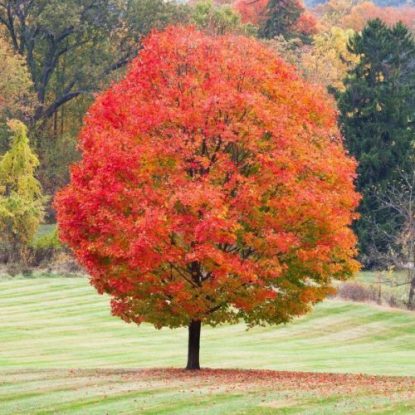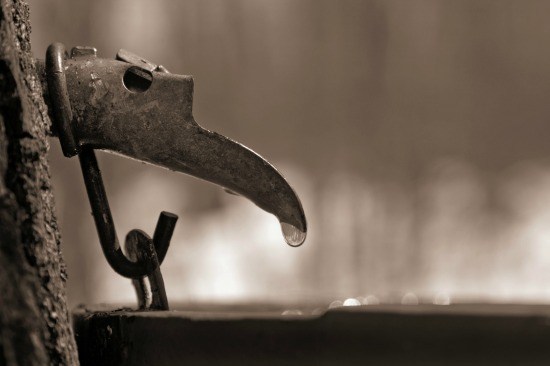The freshest, unprocessed, maple syrup comes directly from trees and you can tap into all of that yummy goodness yourself! Not only does maple syrup taste great, but it can be a potent natural medicine with additional health benefits as well!
The sap in trees contains water and dissolved sugars and other nutrients that travel up towards the branches, feeding the developing leaves. But surprisingly, sap is only about 2% sugar or sucrose depending on the species of tree and is also good for bone health. It has been shown to contain 16 times the potassium, 37 times the calcium, and 3.9 times the magnesium of spring water. All 3 of these minerals are essential nutrients for optimal bone health. Just as calcium and potassium are two minerals that function in supporting optimal bone health, they also play a role in regulating blood pressure. Sap also supports a healthy immunes system and is an antioxidant!

*Sap is a clear fluid and it looks like water.
TREES YOU CAN TAP FOR SAP
- Maple – Sugar maple, silver maple, red maple
- Birch tree
- Black walnut tree
*Other trees to tap include: Heart Nut, Butternut, Beechnut, Hickory, Sycamore, Hop Hornbeam, Bow Elder, Alder, Elm, Gorosoe, Linden or Basswood, and Palm
Sugar Maple tree pictured below:

If you’d like to try to tap a tree and harvest some delicious and nutritious sap for syrup, choose trees that are at least 12-inches in diameter and not diseased or damaged. If a tree is larger, about 24-inches in diameter or more, you can use more than one tap.
You also should bear in mind that most trees are tapped in the early spring (from February through March) depending on the type of tree and your location. Trees are best tapped when the temperature is warm during the day and still cold at night. Typically, the sap flows best with these fluctuations in temperature because this gives the sap a chance to flow up during the day, and down at night. Sap flow usually lasts for about 5 weeks.
HOW TO TAP A TREE AND GET SAP
First, you’ll need to gather a few supplies:
- Drill
- Drill Bit (corresponds to the size of spile)
- Spile(s)
- Food Grade Bucket
- Container or Jug
- Food Grade Hose
Make sure you’ve properly sterilized the drill bit, spile(s), buckets, hose, and containers.
If you don’t have anywhere locally that sells spiles, try Amazon. There are several options to choose from. These come as a “tapping kit” with a corresponding hose.
Once you’ve gathered the supplies necessary and know which tree you’re going to tap, it’s time to get started! You can watch the entire process in the video below:
HOW TO TAP FOR SAP
- Start on the sunny side of the tree, usually the south side. Use a drill bit that is about 5/16″ and make the hole about 2½ inches deep. Angling the hole slightly upward will help the flow.
- Insert the spile (the tube that carries the sap out of the tree and into the bucket). You can use a bamboo tube that has an angle cut on the end.
- If your spile doesn’t already have a hook attached, cut a few notches in it to hold the bucket. You can also nail a hook into the tree. This won’t hurt the tree if it is removed when you’re done. Hang the bucket and cover it to keep rain and debris out of it.
- If all goes well and the temperatures stay above freezing during the day, you can get anywhere from 10-70 gallons of sap from a single tree. Be sure to cover and refrigerate (or even freeze) your sap until you’re ready to turn it into syrup.
Once you’ve retrieved your tree sap, you have a few options. You can either drink the sap straight from the tree or boil it down into delicious syrup. Some suggest you always boil tree sap to remove any micro-organisms that could be living in the liquid, however, use your best judgment.

TO MAKE MAPLE SYRUP
For a gallon of maple syrup, you’ll need about 40 gallons of sap. Depending on how many trees you’ve tapped and how much sap they produced this is entirely feasible. Turning sap into syrup is the simple process of boiling the water off so you’re left with the sugary thick and almost candy-like syrup we all are familiar with.
- Boil the sap down in a large kettle, being sure to keep a lot of sap in the kettle at all times.
- Watch it closely, as the sap boils down fast.
- When the sap reaches 219°F, you’ll have pure syrup.
- Filter the syrup while it is still warm. Bottle, label, and refrigerate.
Tree tapping is almost a “lost art” it seems, as most in American tend to go for the processed and synthetic products rather than take the time to reap nature’s benefits. However, tree tapping is something that can be done as a family! After all, what child dislikes maple syrup? Kids will love to see where the sap comes from and the process involved in getting it from the tree to their pancakes. Boiling sap into syrup is also a great way to teach children the science behind evaporation (water transforming from a liquid to a vapor and leaving the sap). So consider letting your kids join in the fun and experience the journey of delicious “tree to table” syrup with you!
source : readynutrition



